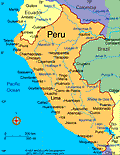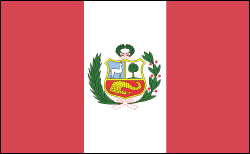Infoplease Atlas: PeruRepublic of Peru
National name: República del Perú
President: Alejandro Toledo (2001)
Prime Minister: Pedro Pablo Kuczynski (2005)
Land area: 494,208 sq mi (1,279,999 sq km); total area: 496,226 sq mi (1,285,220 sq km)
Population (2006 est.): 28,302,603 (growth rate: 1.3%); birth rate: 20.5/1000; infant mortality rate: 30.9/1000; life expectancy: 69.8; density per sq mi: 57
Capital and largest city (2003 est.): Lima, 8,113,000 (metro. area)
Other large cities: Arequipa, 837,300; Trujillo, 725,200; Chiclayo, 598,400
Monetary unit: Nuevo sol (1991)
Languages: Spanish, Quéchua (both official); Aymara; many minor Amazonian languages
Ethnicity/race: Amerindian 45%, mestizo 37%, white 15%, black, Japanese, Chinese, and other 3%
Religion: Roman Catholic 90%
Literacy rate: 91% (2003 est.)
Economic summary: GDP/PPP (2005 est.): $169.5 billion; per capita $6,100. Real growth rate: 5.8%. Inflation: 1.6%. Unemployment: 8.7% in metropolitan Lima; widespread underemployment. Arable land: 3%. Agriculture: coffee, cotton, sugarcane, rice, potatoes, corn, plantains, grapes, oranges, coca; poultry, beef, dairy products; fish. Labor force: 11 million; agriculture 9%, industry 18%, services 73% (2001). Industries: mining and refining of minerals and metals, petroleum extraction and refining, natural gas, fishing and fish processing, textiles, clothing, food processing, steel, metal fabrication. Natural resources: copper, silver, gold, petroleum, timber, fish, iron ore, coal, phosphate, potash, hydropower, natural gas. Exports: $12.3 billion (f.o.b., 2004 est.): copper, gold, zinc, crude petroleum and petroleum products, coffee. Imports: 9.6 billion (f.o.b., 2004 est.): petroleum and petroleum products, plastics, machinery, vehicles, iron and steel, wheat, paper. Major trading partners: U.S., UK, China, Switzerland, Chile, Spain, Brazil, Colombia (2003).
Communications: Telephones: main lines in use: 1.8 million (2000); mobile cellular: 504,995 (1998). Radio broadcast stations: AM 472, FM 198, shortwave 189 (1999). Radios: 6.65 million (1997). Television broadcast stations: 13 (plus 112 repeaters) (1997). Televisions: 3.06 million (1997). Internet Service Providers (ISPs): 10 (2000). Internet users: 3 million (2002).
Transportation: Railways: total: 1,829 km (2002). Highways: total: 72,900 km; paved: 9,331 km; unpaved: 63,569 km (1999 est.). Waterways: 8,600 km of navigable tributaries of Amazon system and 208 km of Lago Titicaca. Ports and harbors: Callao, Chimbote, Ilo, Matarani, Paita, Puerto Maldonado, Salaverry, San Martin, Talara, Iquitos, Pucallpa, Yurimaguas; note: Iquitos, Pucallpa, and Yurimaguas are all on the upper reaches of the Amazon and its tributaries. Airports: 233 (2002).
International disputes: Bolivia continues to press Chile and Peru to restore the Atacama corridor ceded to Chile in 1884.
Major sources and definitions
Geography
Peru, in western South America, extends for nearly 1,500 mi (2,414 km) along the Pacific Ocean. Colombia and Ecuador are to the north, Brazil and Bolivia to the east, and Chile to the south. Five-sixths the size of Alaska, Peru is divided by the Andes Mountains into three sharply differentiated zones. To the west is the coastline, much of it arid, extending 50 to 100 mi (80 to 160 km) inland. The mountain area, with peaks over 20,000 ft (6,096 m), lofty plateaus, and deep valleys, lies centrally. Beyond the mountains to the east is the heavily forested slope leading to the Amazonian plains.
Government
Constitutional republic.
History
Peru was once part of the great Incan Empire and later the major vice-royalty of Spanish South America. It was conquered in 1531–1533 by Francisco Pizarro. On July 28, 1821, Peru proclaimed its independence, but the Spanish were not finally defeated until 1824. For a hundred years thereafter, revolutions were frequent; a new war was fought with Spain in 1864–1866, and an unsuccessful war was fought with Chile from 1879 to 1883 (the War of the Pacific).
Peru emerged from 20 years of dictatorship in 1945 with the inauguration of President José Luis Bustamente y Rivero after the first free election in many decades. But he served for only three years and was succeeded in turn by Gen. Manuel A. Odria, Manuel Prado y Ugarteche, and Fernando Belaúnde Terry. On Oct. 3, 1968, Belaúnde was overthrown by Gen. Juan Velasco Alvarado. In 1975, Velasco was replaced in a bloodless coup by his prime minister, Gen. Francisco Morales Bermudez, who promised to restore civilian government. In elections held on May 18, 1980, Belaúnde Terry, the last civilian president, was elected president again. The Maoist guerrilla group Shining Path, or Sendero Luminoso, began their brutal campaign to overthrow the government. The military's subsequent crackdown led to further civilian human rights abuses and disappearances. A smaller rebel group, Tupac Amaru, also fought against the government.
Peru's fragile democracy survived. In 1985, Belaúnde Terry was the first elected president to turn over power to a constitutionally elected successor since 1945. Alberto Fujimori won the 1990 elections. Citing continuing terrorism, drug trafficking, and corruption, Fujimori dissolved Congress, suspended the constitution, and imposed censorship in April 1992. By September, most of Shining Path had been vanquished. A new constitution was approved in 1993.
Fujimori was reelected in 1995, and again in May 2000 to a third five-year term, after his opponent, Alejandro Toledo, withdrew from the contest, charging fraud. In Sept. 2000, Fujimori's intelligence chief, Vladimiro Montesinos, was videotaped bribing a congressman. Fujimori announced he would dismantle the powerful National Intelligence Service, which has been accused of human rights violations. Two months later, he stunned his nation by resigning during a trip to Japan. Revelations that Fujimori secretly held Japanese citizenship—and could not be extradited to face corruption charges—enraged the populace.
In 2001, the centrist Alejandro Toledo was elected president with 53% of the vote, narrowly defeating former president Alan García. His rags-to-riches story and mixed Indian and Latino heritage made him popular among the poor. Inheriting a country wracked by economic troubles and corruption, Toledo did little, however, to restore confidence in the government. Early in his presidency, he gave himself a significant pay raise while at the same time calling for economic austerity. In June 2002, a popular revolt took place in the cities of Arequipa and Tacna and in other areas of southern Peru after the sale of two state-run electricity firms to a Belgian company, Tractebel. Toledo had specifically promised during his campaign not to sell these firms. Opinion polls have revealed that more than 60% of Peruvians are adamantly opposed to privatization and foreign investment, which in the past has led to price increases, mass layoffs, corruption, and few discernible benefits for the populace. To quell the rioting, Toledo suspended the decision to privatize, apologized publicly, and reshuffled his government.
In Aug. 2003, a truth commission report revealed that 69,000 people were killed during the 1980–2000 wars between rebel groups and the government, about twice the original estimate. The deaths were carried out by the rebels (54%) as well as the military (30%); other militias were responsible for the remainder.
Since Toledo took office in 2001, the economy has grown annually by about 4%, but this growth, centered on mining and the gas industry, has not yet created new jobs. A series of scandals and political missteps have made Toledo Latin America's least popular leader. According to a variety of polls taken between 2003 and 2005, his approval rating has ranged from 8%–14%.
In the first round of presidential elections in April 2006, voters chose a former army officer, Ollanta Humala, from among 20 candidates. Because he won with just 31% of the vote, a second runoff election will take place in May or June.
See also Encyclopedia: Peru. National Institute of Statistics and Informatics (In Spanish only) www.inei.gob.pe/ .

